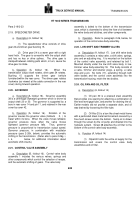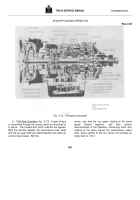TM-5-3805-254-14-P-2 - Page 695 of 894
TRUCK SERVICE MANUAL
HT 700D SERIES TRANSMISSIONS
Para 2-26
calibrated springs.
Each of the shift valves and springs
are calibrated to insure that the valves will shift at the
proper time and in proper sequence.
At a given
governor pressure, an increase in modulator pressure
will upshift a signal valve.
A decrease in modulator
pressure will cause a downshift if governor pressure
alone will not hold the valve upward.
(4)
A t the trimmer regulator valve, modulator
pressure assists in regulating the trimmer regulator
pressure against the spring at the top of the valve.
(5)
A t the lockup valve, modulator pressure
causes lockup to occur at a lower vehicle speed.
i. Trimmer Regulator Valve
(1)
The trimmer regulator valve reduces main
pressure to a regulated pressure.
The regulated
pressure i s raised or lowered by change s in modulator
pressure (red and green).
(2)
Trimmer regulator pressure is directed to
the lower side(s) of the trimmer regulator plug(s) to vary
the clutch apply pressure pattern of the trimmer valves.
A higher modulator pressure (closed throttle) will reduce
trimmer regulator pressure.
This results in lower initial
clutch pressure.
Conversely, a lower modulator pressure
(open throttle) results in higher regulator pressure and a
higher initial clutch pressure.
j. Trimmer Valves
(1)
The purpose of the trimmer valves is to
avoid shift shock.
The valves reduce pressure in the
clutch apply circuit during initial clutch application, then
gradually returns the pressure to the operating
maximum.
This applies the clutch gently, and harsh
shifts are prevented.
(2)
Although each trimmer valve is calibrated
for the clutch it serves, all trimmers function in the same
manner.
Each trimmer includes (from top to bottom) an
orificed trimmer valve, trimmer valve plug, trimmer spring
and stop pin.
(3)
When any clutch (except forward) is
applied, apply pressure is sent also to the upper end of
the trimmer valve.
Initially, the valve and plug are forced
downward against the trimmer spring until oil escapes to
exhaust.
This escape of oil, as long as it continues,
reduces clutch apply pressure.
However, oil flows
through an orifice in the trimmer valve to the cavity
between the trimmer valve and plug.
Pressure in this
cavity forces the plug farther downward, to the stop.
The
plug stops, but flow through the orifice in the trimmer
valve continues.
The pressure below the trimmer valve,
because it is acting upon a greater diameter than at the
upper end, pushes the trimmer valve to the top of the
valve bore.
This throttles, then stops, the escape of oil to
exhaust.
When escape of oil is stopped, clutch apply
pressure is at maximum value.
The plug remains
downward, against the stop, until the clutch is released.
(4)
When the clutch is released, the trimmer
spring pushes the trimmer components to the top of the
bore.
In this position, the trimmer is reset and ready to
repeat the trimming action when its clutch is again
engaged.
(5)
A trimmer boost accumulator valve is
connected to the trimmer regulator pressure circuit.
The
accumulator will absorb surges in the trimmer regulator
pressure and provide a more uniform regulator pressure.
k. Lockup Circuit (Actuated
by front governor)
(1)
The front governor circuit originates at the
front pitot.
Rotation of the vaned pitot collector ring
directs oil against, and into, the pitot orifice.
This
produces a pressure in the front governor circuit which
varies with the rotational speed of the collector ring.
Pressure increases as speed increases.
This pressure
is directed to the top of the lockup valve.
(2)
When front governor pressure (or front
governor pressure assisted by modulator pressure) is
sufficient to compress the spring at the bottom of the
valve, the lockup valve moves downward.
In this
position, the
688
TRANSMISSION
Back to Top




















